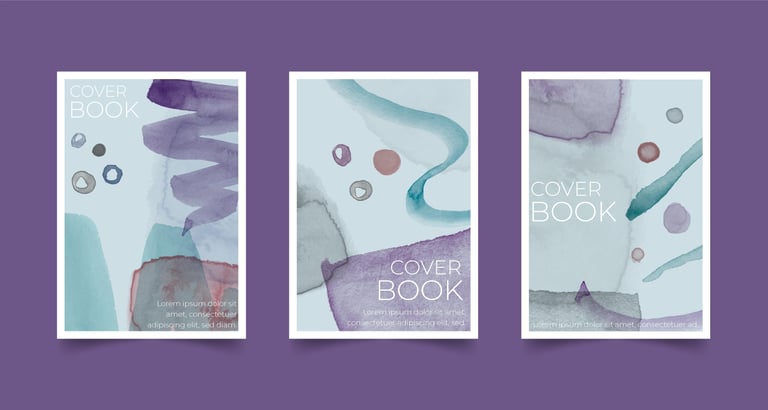Graphic design and book design are cousins, not siblings. They share common ancestors in typography, layout, and visual communication—but over time, they’ve specialized, grown apart, and serve very different functions.
You wouldn’t ask an architect to wire your house. Likewise, you shouldn’t hand your novel or memoir to a generalist logo or ad designer and expect a well-crafted, professionally laid-out book. The tools might be similar, but the skills, the experience, the approach, priorities, and purpose are entirely different.
Let’s break it down.
Graphic Designers Are Visual Problem Solvers
Graphic designers are trained to communicate messages visually, often with brevity, punch, and brand impact in mind. Their world revolves around:
Logos
Posters
Websites
Ads
Social media graphics
Packaging
These deliverables are short-form, marketing-driven, and designed to attract attention quickly and convey meaning instantly. The work demands a keen sense of trend, rhythm, branding, and visual hierarchy—all of which are essential in fast-paced digital and print media environments.
But hand them a 350-page manuscript, and the situation changes drastically.
Book Designers Are Long-Form Design Specialists
A book designer doesn’t just “make it look nice.” They’re fluent in the language of reading—a language that demands balance, rhythm, and typographic sensitivity across potentially hundreds of pages.
They don’t just design pages. They shape the reading experience.
As designer Michael Lines aptly put it:
“A logo designer would make you a pretty cover, and a book designer knows things like kerning, hyphenation, ligatures, widows and orphans, and print-safe layout specs.”
That’s the heart of the matter.
A great book designer is part typographer, part production technician, part layout engineer, and part visual storyteller. Their job is invisible elegance: creating a reading experience so fluid and inviting that the design disappears, leaving only the words—and their impact.
A Book Designer Knows:
Kerning & Letterspacing: Adjusting the space between letters to improve word shape and page texture.
Hyphenation Rules: Avoiding clumsy line breaks that interrupt natural reading flow.
Ligatures: Typographic refinements that smoothen the appearance of certain letter pairs (like fi, fl, ffl).
Widows & Orphans: Preventing single lines of text from being stranded at the top or bottom of pages—because reading rhythm matters.
Margins, Bleeds & Trim Zones: Ensuring your content stays intact during binding and trimming, especially with platforms like KDP and IngramSpark.
Typographic Hierarchy: Balancing chapter titles, subheads, body text, and footers so that everything feels cohesive and intuitive.
Platform Requirements: Understanding the fine print and template specs for various print-on-demand services and offset printing.
A Graphic Designer Might Know:
How to design eye-catching logos
Create marketing visuals and promo assets
Select trendy color palettes and fonts
Work with RGB or CMYK settings
Use tools like Adobe Illustrator, Photoshop, or Canva
While they may be skilled, they are often not trained in long-form typography, print production, or reader-centric layout.
Asking a branding designer to typeset your novel is like asking a jingle writer to compose a symphony.
Fix: Hire a Book Design Specialist
Your book is not a brochure. It isn’t an ad. It’s a complete ecosystem—cover, spine, back cover, front matter, chapters, endnotes, index, and more—each requiring careful attention.
A book designer will bring harmony, rhythm, and clarity to your story. They will:
Select fonts that reflect your tone and genre
Format every page to avoid distraction and fatigue
Ensure consistency across sections, chapters, and styles
Prepare files that won’t get flagged or rejected by Amazon, IngramSpark, or your printer
Help your book feel timeless, professional, and worth the read
In the world of publishing, your design isn’t just decoration—it’s credibility. Don't cut corners.
Bottom Line
Designing a book isn’t the same as designing a flyer or social media graphic. It’s a craft—one that respects the reader’s eye, the author’s voice, and the publisher’s standards. When you're ready to bring your manuscript into the world, invest in a professional who understands the full scope of what that means.
Because your book deserves more than just to look good. It deserves to read beautifully, too.


Book Design Is Not Graphic Design—Here’s the Difference
J U L Y 2 0 2 5

Bio
I'm Okang’a Ooko—a novelist and senior book designer with deep roots in publishing, storytelling, and design. I specialize in helping publishers and agents deliver polished, compelling books that resonate with their markets. Whether you’re producing high-volume titles or championing a first-time author, my design solutions ensure your books look as powerful as the stories they tell, captivating readers, and reflecting professional quality from cover to final page. As an author, my novels explore history, politics, culture, music, love, and identity—told through emotionally rich, character-driven narratives that captures nostalgia, societal conflict, and the personal struggles of those facing change and disconnection. Read more »
Ready to transform your story into something unforgettable? Okang'a Ooko specializes in end-to-end creative solutions for authors, publishers, literary agents, and storytellers. Whether you're crafting your first novel, launching a brand, or building an author platform, he's here to guide you from concept to creation. Learn more »
With decades of experience in storytelling, publishing, and visual design expertise. Ooko helps you bring your book, brand, or message to life—beautifully, strategically.
Turn your vision into a lasting impression. Hire Okang'a Ooko »
Hire Okang'a Ooko
Connect With Me
© 2025. All rights reserved.
Terms and Conditions I Refund Policy I Privacy Policy
